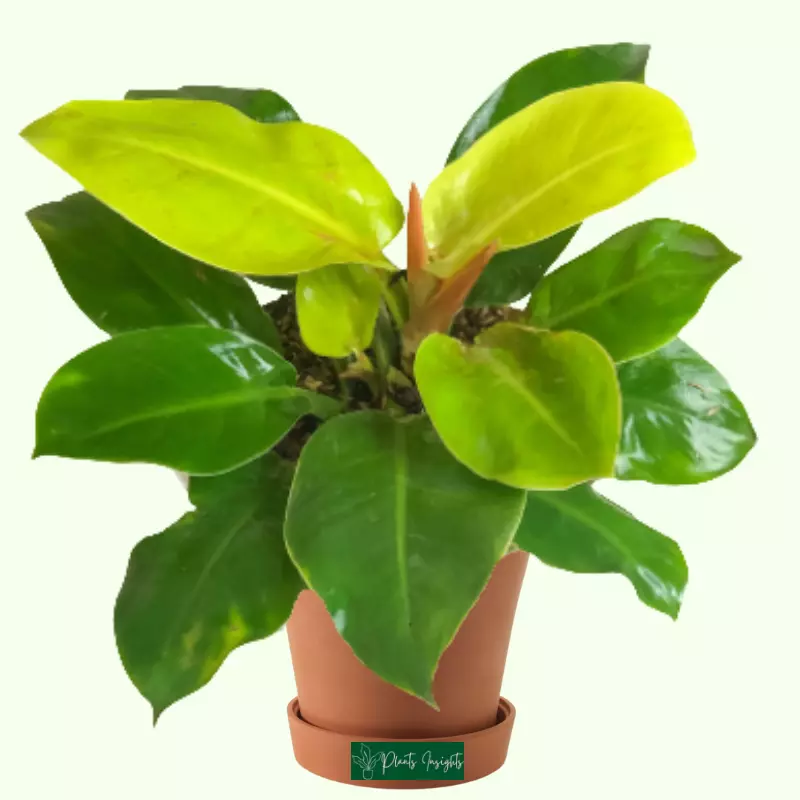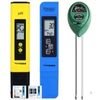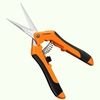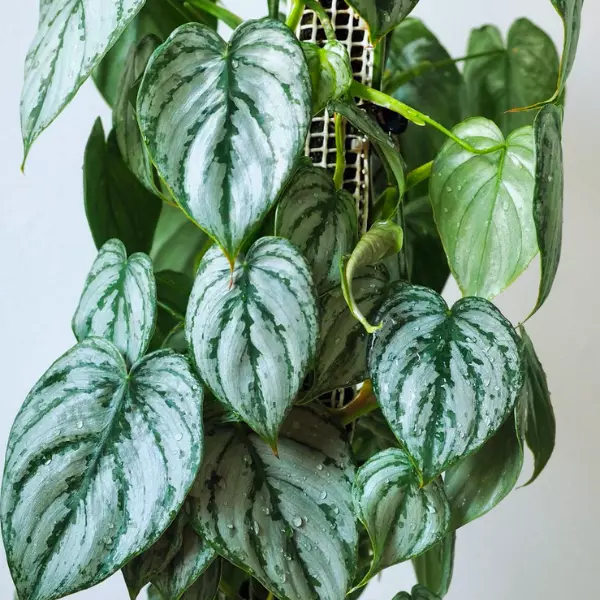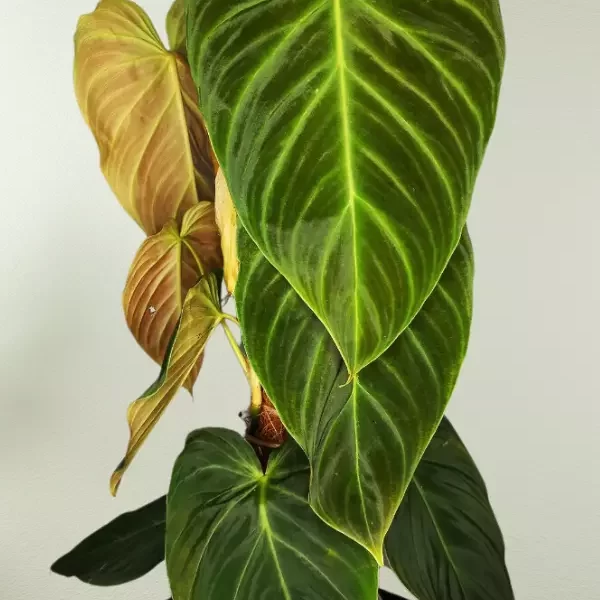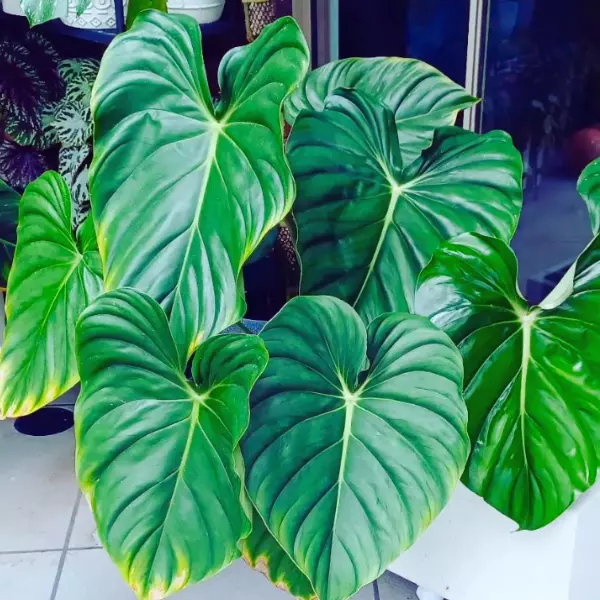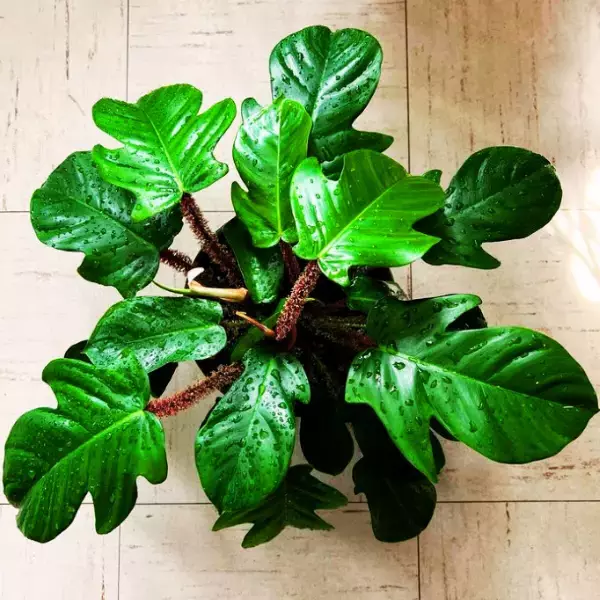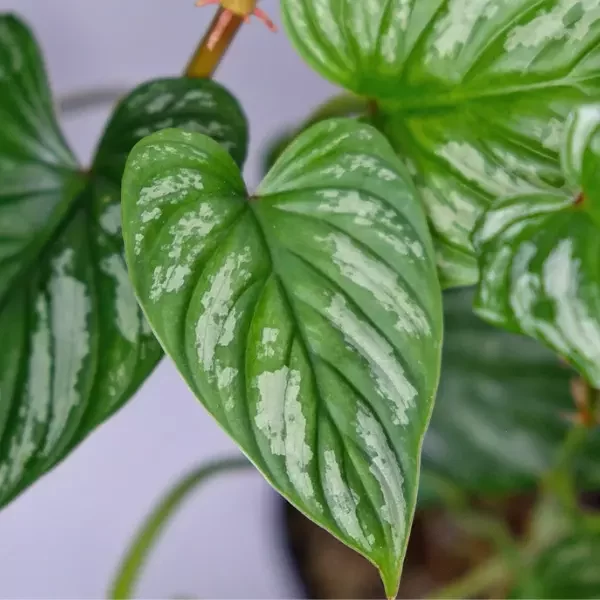Philodendron Moonlight is a remarkable, eye-catching houseplant with which you may instantly fall in love featuring massive arrow-shaped leaves that exhibit a beautiful lime green kind of chartreuse, almost fluorescent colour that this plant gives off. Lemon yellow new leaves turn into bright emerald green foliage over time. In person, you can enjoy the sheer beauty of this elegant and gorgeous plant more than in pictures.
Moonlight is a flowering perennial clumping cultivar known as lime Philodendron due to its newly grown bright yellow-green chartreuse-colored leaves. Its unfurled leaves are luminescent like the moon before turning green, hence earning the name Moonlight Philodendron. The Moonlight Philodendron is a hybrid variety of the Philodendron genus from the Araceae family grown for its vivid foliage.
Allied Species: Philodendron Florida Ghost, Philodendron Verrucosum,Philodendron White Wizard, Philodendron White Princess, Philodendron White Knight, Philodendron Rugosum, Philodendron Spiritus Sancti ,Philodendron Pastazanum.
Essential Products
Habitat & Ecology
This stunning variety Originates from the dense tropical canopies of Central and South American rainforests. Moonlight Philodendron is primarily grown as an indoor plant; however, it also flourishes outdoor in hardiness zones 10-11. Moonlight can give a great color contrast to the garden’s green foliage plants in shady spots.
Philodendrons are known to purify airborne toxins such as trichloroethylene, formaldehyde, and benzene from the air. They are great air purifiers for offices and apartments.
| Botanical Name: | Philodendron Moonlight |
| Family Name: | Araceae |
| Common names: | Moonlight Philodendron, Lime Philodendron |
| Plant type: | Tropical flowering perennial bushy plant |
| Origin: | Central and South America |
| Bloom: | White spadix and a Pink spathe |
| Height: | 20 to 24 inches (50 cm) tall |
| Preferred pH | 5.0-7.0 |
| Humidity: | 50% or higher |
| Hardiness Zones | 10 to 11 |
| Temperature | 65 ºF to 80 ºF |
| Light Need | Bright, indirect light |
How do You Care for a Philodendron Moonlight?
Recently, Philodendron Moonlight has gained popularity and is loved by indoor growers due to its low maintenance and vivid colored, thick, glossy leaves. Over the years, I have learned the optimal way to care for Philodendron’ Moonlight’. In this guide we have covered the basic requirements to take care of Philodendron’ Moonlight’ to maintain the beautiful texture and foliage of this beauty for years to come.

Size & Growth
When leaves unfurl, they are a light green, almost chartreuse color and then as they age, they change into deeper, darker emerald green coloration. So, the contrast there is just remarkable, vivid and pretty.

As the leaves mature, they do get kind of larger, and they do kind of get a little ribbed. They won’t lose their coloration too much; they hold on to it Moonlight is a hybrid cultivar; hence, it doesn’t get too large. This fluorescent green philodendron is more of a clumping kind of shrub-like variety.
Is Philodendron Moonlight a vine?
Unlike other Philodendrons such as Florida Ghost, and Verrucosum which are climbers, Moonlight is not a climber or a creeper; instead, it clumps up and gets to about 20 to 24 inches (50 cm) tall and about 20 to 26 inches wide. So, it does get a little bit wider than it gets taller, but they are a good-sized tabletop plant.
Unlike climbing philodendrons, which need a moss pole for support, the Moonlight Philodendron leaves grow very close together in a rosette, making them an excellent choice for hanging baskets.
Flowering
Moonlight produces inflorescence featuring a 5″ inch white spadix and a pink spathe surrounding the spadix , and the bloom may last for a month. The plant may bloom at any time of the year, but the chances of blooming in summer are high. It is hard to get flower indoors but if grown outside they probably will be more likely to flower.

Does Philodendron Moonlight Need Direct Sunlight?
Philodendron Moonlight thrives in places with bright indirect sunlight. The ideal location for this plant is an east-facing window where it can get plenty of morning sunlight. This plant can enjoy morning and evening direct sunlight but for the rest of the day, keep it in a place with indirect sunlight. If the leaves start discoloring , move the plant a bit away from the window.
If you place it in a northern window, you would definitely have to supplement with grow lights. Moonlight is marketed as a low-light tolerant plant, but it can grow leggy and may produce smaller leaves in low light.
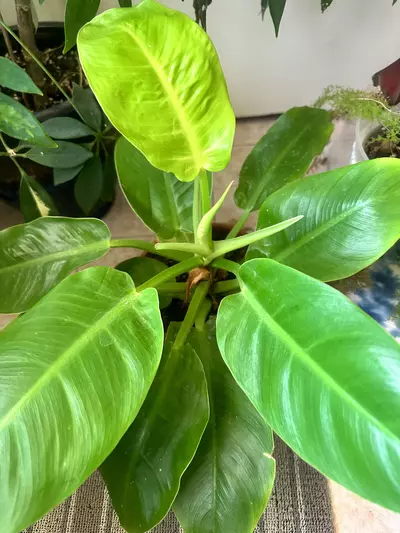
This plant stays happy in moderate indirect sunlight. Please ensure not to let the leaves receive too much direct sunlight since the intense sunlight may scorch the foliage.
In the Northern Hemisphere, south-facing windows get a high amount of direct sunlight; therefore, keep the plant at least two feet away from the window to avoid foliage burning. If grown outside, keep the plant in shady places or where it gets morning or evening direct sunlight for only a couple of hours.
These plants are typically found in the canopy, so they don’t get a whole bunch of light -they always get filtered sunlight.

Watering
Philodendron Moonlights are moderate drinkers. Water your plant when the top two inches of the soil feels dry. You can check the dryness of the soil by putting your finger in the potting mix or using a Moisture meter to monitor the dryness.
When the plant is thirsty or underwatered, the leaves start to sag and wilt, letting you know they need more water. Water the plant thoroughly and let the excess water drains out completely. Since Philodendrons are prone to root rot, the plant must not sit in damp soil. Otherwise, it may suffer from yellowing of leaves.
Philodendron moonlight may need watering once a week during the growing season, from spring until mid-autumn. However, the plant is dormant in winter and needs to be watered every 7-10 days. Remember, the plant’s watering depends on several factors such as temperature, humidity, the intensity of light, and the plant’s size. Hence, checking the top two inches of soil before watering is recommended.

Temperature & Humidity
Philodendron Moonlight is a tropical plant; therefore, mimicking the tropical climate will let this plant thrive. It prefers high humidity and a warm, humid temperature climate. This plant thrives indoors at a temperature around 65ºF to 80 ºF (18-26 Degrees Celsius).
Moonlight is a warmth-loving plant; if the temperature drops below 55 ºF, it may have poor stunted growth. Remember, Philodendron varieties struggle to grow below 60 F (15 C) temperature. Therefore, keep the plant away from A.C vents and cold windows during winter.
As mentioned earlier, it can be grown outside; therefore, you must be careful about keeping this plant outdoors and if the temperature drops below 55 ºF, bring it inside.
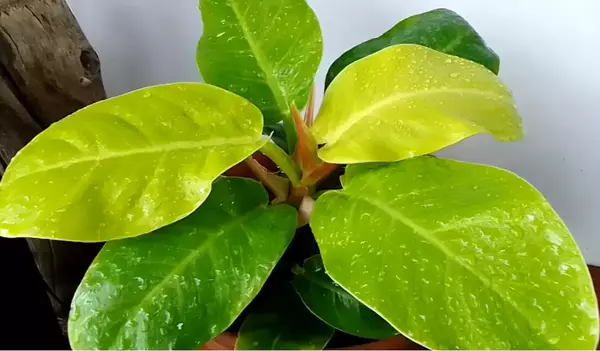
Even though Philodendron Moonlight is a tropical plant, Moonlight is not as pretentious as other philodendrons regarding humidity. Ideally, it prefers a humidity of 50% percent or higher. However, it can tolerate the average household humidity, which may be less than 50%, especially during winter. Moonlight’s thick leathery foliage can withstand low humidity without turning brown, crispy edges.
If you want Moonlight to stay happy, we recommend misting it with tepid water or using a plant humidifier. Moreover, keeping the plant on top of a pebble tray will also increase the humidity in the surrounding. We recommend using a Hygrometer to monitor temperature and humidity for optimal care.


Potting Mix
Philodendron Moonlight prefers well aerated, porous, moist soil rich in organic matter. The regular potting mix is a dense medium for Philodendrons as their roots need oxygen flow. This plant does not like a dry or damp substrate. We recommend using a light Aroid potting mix for Philodendron Moonlight.
You can also make your own potting medium by following this recipe;
This potting mix provides airflow to the roots, retains moisture, and has antifungal and antibacterial properties. Root rot and other fungal diseases can be prevented by efficient drainage and aeration, supported by the above substrate.
pH– Moonlight Philodendron prefers slightly acidic to neutral soil of 5.0-7.0 pH.

Fertilizing
Philodendrons are usually grown for their beautiful foliage; hence any nitrogen-based fertilizer may boost the foliage growth, especially during the growing season.
You can either use a slow-release fertilizer or a balanced liquid fertilizer (Noot Organic Plant Food) for Philodendron Moonlight. Fertilize once a month during the growing season to encourage new growth. However, you can feed the plant in winter every 6 to 8 weeks.
You can use a slow-release fertilizer or all-purpose balanced liquid fertilizer with a 10-10-10 nutrient ratio to feed Philodendron Moonlight. It is preferable to water the plant before fertilizing it to avoid any leaf burning. Similarly, dilute the liquid fertilizer before feeding and adjust the dosage depending on the plant’s response.
You can also use organic fertilizer like manure or compost. If you notice slow growth or small leaves , it indicates your plant needs fertilizing

Repotting Philodendron Moonlight
The Philodendron Moonlight needs to be re-potted quite often. They have a lot of root growth that need to be re-potted about once a year. You can determine if the plant needs repotting by inspecting the drainage holes. If the roots grow out of the drainage holes, the plant is root-bound and requires repotting. You can re-pot the plant by following the step-by-step guide;
We recommend re-potting the plant in spring or early summer to give plant time to adjust during growing season.

Pruning and Maintenance
Philodendron Moonlight doesn’t require frequent pruning as this is a low-height, compact-shaped plant. However, it would be best to prune some of the older, yellowing leaves or astray stem. Keep inspecting the plant regularly and if you find any damaged or broken leaves , make sure to snip them off. Always use a sharp, sterilized shear or scissors to prune the plant.
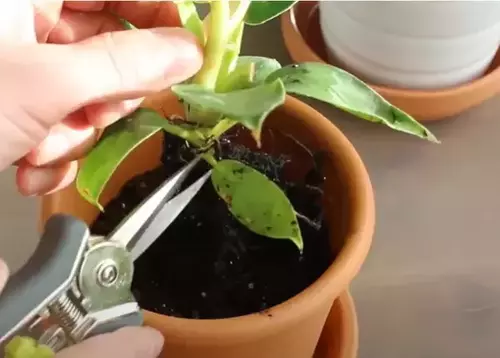
If you are growing Philodendron Moonlight indoors, we recommend wiping the leaves with a damp cloth to remove any dust or pests. Moreover, frequent rinsing of leaves prevents dust from clogging the plant’s pores and help them do photosynthesis better. I make my cleaning solution by following ingredients;
- One part Lemon juice
- Three parts warm water

Philodendron Moonlight Propagation Guide
Plant propagation is an economical way of multiplying your plants. Like most Philodendrons, the easiest and most effective propagation method is through stem cutting. However, horticulturists also propagate this plant through tissue culture, which is slow and hectic for beginners.
Moreover, a mature Philodendron Moonlight can also be propagated through plant division by separating it into several clumps and planting them in separate pots.
Steps for Stem Cutting Propagation
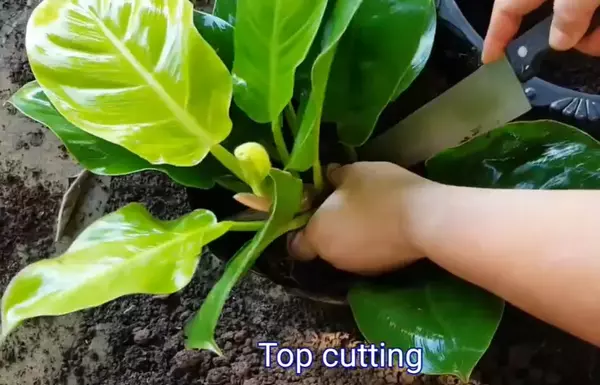
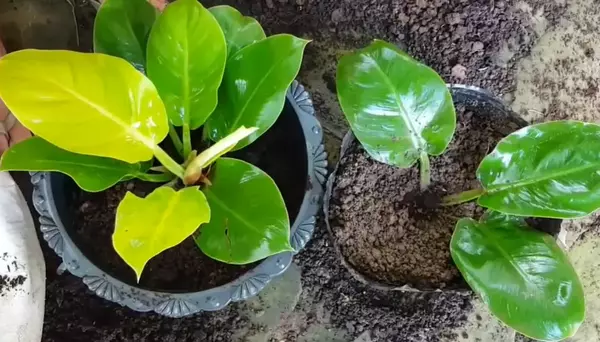
You can also root the cutting in water or sphagnum moss if you feel the stem cutting has minimal aerial roots. Once the cutting has strong roots, you can plant them in a suitable potting mix.
Remember to keep the substrate light, well-drained and moist for the plant to thrive. The best time for propagation is spring or summer when the plant is active and can adjust the change.

Is Philodendron Moonlight Plant Toxic?
Philodendrons are usually toxic to pets, including cats and dogs, as the leaves contain calcium oxalate crystals, which can cause skin irritations, nausea, vomiting, and difficulty breathing. When ingested by pets, the symptoms would be drooling, pawing at the mouth, and less appetite.
Therefore, we suggest keeping the plant away from pets and children as Philodendron Moonlight plant is mildly toxic.

Common Pests and Problems
Philodendron Moonlight’s thick leaves are resistant to pests and diseases and can tolerate low humidity. However, the leaves may burn if exposed to intense light. A few common problems that your Moonlight may face are :
Root root
Moonlight may suffer from root rot if potted in a dense medium or sitting in damp soil. Similarly, if water before the top soil dries, it may suffer root rot, and the leaves start yellowing as symptoms.
Leaves With Brown Spots
If the leaves have brown spots, it could be due to fungal problems, or they are getting too much sunlight. Moreover, if you head shower the plant and the water doesn’t dry off the leaves, it can also cause the fugal problem, and as a result, brown spots may appear.
Brown Leaf Tips
A lack of moisture can cause a Moonlight Philodendron’s brown leaf tips. This plant is tropical and needs high humidity and moist soil to thrive. If the plant dries out completely between watering, it can cause the browning of tips. Water your Moonlight as soon as the top two inches of soil dries.
Moreover, over-fertilizations can cause browning of leaves tip. When watering the plant, give a good drink until the excess water drains out to remove accumulated salts.
Yellowing of Leaves
The yellowing of leaves may cause due to overwatering. The plant doesn’t like to sit in water or damp soil. Moreover, the plant may have pale leaf color if it does not get enough light. If your stem-cutting leaves start turning paler, it is a symptom of root rot.
Leaves With Yellow Streaks
The mosaic virus can cause yellow streaks in the leaves. Beware, this is not variegation of the Philodendron Moonlight plant. It can distort the leaves.
Drooping Leaves
The leaves may droop due to over or under-watering. Root rot also causes your plant’s leaves to either droop or wilt. A few pests and diseases can cause drooping leaves. Try to be fairly intimate with your plant, pick it up occasionally, and check for any pest problems.
The Moonlight is not prone to pest infestation but may encounter problems like scale occasionally, Mealybugs, thrips and once in a while with spider mites.
Spider Mites
The Spider mites sometime go un noticed as they usually live underside of the leaves. They are like white or yellow spots on leaves . They produce silky webs around plant’s leaves and cause yellow and brown appearance of the leaves.
To get rid of Spider Mites , put the plant in the bath tub and shower it off. Moreover, ladybugs are natural solution to keep the Spider Mites in control. In addition , applying Neem oil on the plant’s leaves or using a Isopropyl alcohol help get rid of spider Mites.
Scale
Scales are often overlooked by plant parents as they are immobile and look like small bumps on the plant. They can cause stunted growth and yellowing of leaves. If you notice scale you may need thumbnail or a knife or any other flat kind of sharp tool to scrape those off. You can also feed some systemic pesticides that plant will absorb and kill the scales.
Mealybugs
It is another pest you need to look for on your Philodendron Moonlight. Mealybugs are related to scale insects and produce white cotton-like substance on the underside of the leaves. They feed on plant’s sap and weakens the plant. You can apply rubbing alcohol on plant’s leaves and stems using a cotton swab.
You can spray the Neem oil mixed with water on plant to fight pest infestation.
Aphids
These are yellow, brown, or orange bugs that feed on the Plant’s sap or juice. Using an insecticidal soap or Neem oil can kill them
FAQs
Is Philodendron moonlight an indoor plant?
Philodendron Moonlight is an attractive indoor plant but can be grown outside in shady places with warm and humid climate. It may not tolerate direct intense sunlight and low temperatures such as below 55 degree Fahrenheit.
Does Philodendron Moonlight climb?
Philodendron Moonlight is a self heading plant in a rosette form. It is not a climber or a vine. It grow into a small bush like plant.
What is the difference between Philodendron Lemon Lime and Moonlight?
They both are from Philodendron Genus but have evident differences.
Philodendron Lemon Lime vs Moonlight
The main difference between Philodendron Lemon Lime and Moonlight is the color and shape of the leaves. Lemon Lime Philodendron has small ,heart-shaped leaves that are paler than Moonlight ‘s leaves. Whereas Moonlight leaves are bright , elongated and spear shaped.
Philodendron Lemon Lime grows as a vine , while Moonlight is a self-heading Philodendron ( a bushy plant). Lemon Lime Philodendron may need frequent pruning as this is a vine but Moonlight on the other hand, need occasional pruning. Since Lemon lime is vine and may need a support to climb on to something but Moonlight don’t need any support.
Why is my Philodendron ‘Moonlight’ Turning Brown?
The leaves may turn brown due to low humidity or too much light exposure. You can increase the humidity by using a plant humidifier . Moreover , you can move the plant away from the bright spot to avoid browning of leaves.
Conclusion
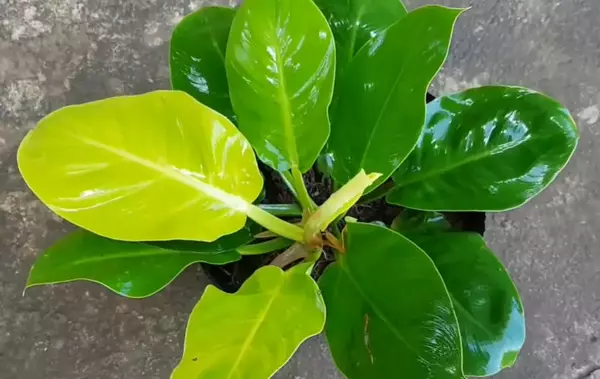
Philodendron ‘Moonlight’ is a stunning house plant featuring large, glossy, neon green leaves and low maintenance – perfect for indoor gardeners to add colors in their collection. Moreover, it is resistant to most pests and diseases, so growing this plant won’t be hassle .
Related Posts
Philodendron Brandtianum Care Guide
Philodendron Brandtianum, also known as the Silver Leaf Philodendron is a low-maintenance vining houseplant.
Philodendron Splendid Care and Propagation Tips
Philodendron ‘Splendid’ is a stunning hybrid of two stunning species of the Araceae family: Philodendron Melanochrysum and Verrucosum.
Philodendron Pastazanum Care Guide for Successful Growth
Philodendron Pastazanum is a stunning crawler plant with impeccably sized glossy leaves. It’s one of the easiest philodendron houseplants,
Philodendron Squamiferum Care & Growing Guide
Philodendron Squamiferum also known as the “hairy” or “red-bristle” Philodendron, is native to the rainforests of Central America, French Guiana, and Brazil,
Philodendron Mamei (Silver Cloud) Care and Growing Tips
Philodendron Mamei is an amazingly low-maintenance, classic heart-shaped Philodendron, making it a perfect choice as houseplant.

